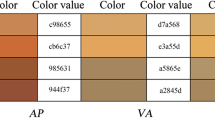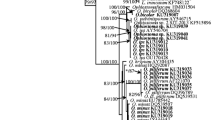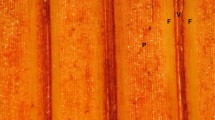Abstract
Wooden blocks of Norway spruce were coated with different paint formulations. Water- and solvent-borne model and commercial paints were used. The coated wooden blocks were inoculated with a spore suspension of Aureobasidium pullulans (de Bary) Arnaud and placed in an environment of high humidity for 14 months. Different levels of fungal stain and variable growth patterns were observed on the different coated samples. Fungal growth in the form of hyphae was observed on the paints that became heavily stained, and yeast-like cells occurred on the paints that became less stained by the fungus. Towards the end of the incubation period commercial paints containing a fungicide became more stained than the same paint formulations without fungicide.
Zusammenfassung
Fichtenblöcke wurden mit verschiedenen Anstrichsystemen beschichtet. Experimentelle und kommerzielle Anstriche auf Wasser- und Lösemittelbasis wurden verwendet. Die beschichteten Blöcke wurden mit einer Sporensuspension von Aureobasidium pullans (de Bary) Arnaud inkubiert und bei hoher Feuchte 14 Monate lang gelagert. Verschiedene Grade der Verfärbung und Wachstumsmuster wurden registriert. Hyphenentwicklung war vor allem bei stark verfärbten Farbschichten zu beobachten, während auf weniger verfärbten Proben die Pilze eher Hefezellen glichen. Gegen Ende der Testzeit waren die kommerziellen Anstriche, die Fungizide enthielten, stärker verfärbt als die gleichen Anstriche ohne Fungizide.
Similar content being viewed by others
References
Boutelje JB (1990) Increase in the content of nitrogenous compounds at lumber surfaces during drying and possible biological effects. Wood Sci. Technol. 24: 191–200
Bjurman J, Jönsson S, Herder C, Sjöblom E (1991) Missfärgande svampars angrepp p mlade ytor. Färg och Lack Scandinavia 9, 185–190 (In Swedish)
Bjurman J, Herder C (1992) Susceptibility of painted wood to discolouring fungi — influence of binder, solvent and surfactant Internat. Res. Group on Wood Pres., Doc. No IRG/WP/3714-92*
Bjurman J (1994) Mould growth on painted wood. In Durability of Exterior Wood Panelling Proceedings from a Nordic Conference, Ed. Bjurman, J., April, 1994, Uppsala, Sweden: 151–156
Dickinson DJ (1971) Disfigurement of decorative timbers by blue stain fungi. B.W.P.A. Ann. Conv. 1971, 9: 151–169
Horvarth RS, Brendt MM, Cooper DG (1976) Paint deterioration as a result of the growth of Aureobasidium pullulans on wood. Appl. Environ. Microbiol. 32: 505–507
Jakubowski JA, Gyris J, Simpson S L (1983) Microbiology of modern coating systems. J. Coat. Tech. 55: 49–53
King B, Oxley TA, Long KD (1974) Soluble nitrogen in wood and its redistribution on drying. Mat. u. Org. 9: 241–254
King B, Oxley TA, Long KD (1976) Some biological effects of redistribution of soluble nutrients during drying of wood. Mat. u. Org. 3: 263–276
Kockova-Kratochvilova A, Cernakova M, Slavikova E (1980) Morphological changes during the life cycle of Aureobasidium pullulans (de Bary) Arnaud. Folia Microbiologica 25: 56–67
Molin P, Gervais P, Lemiere JP, Davet T (1992) Direction of hyphal growth: A relevant parameter in the development of filamentous fungi. Research in Microbiology 143: 777–784
O’Neill TB (1986) Succession and interrelationships of microorganisms on painted surfaces. J. Coat. Tech. 58: 51–56
Ramos S, Garcia-Acha I (1975) A vegetative cycle of Pullularia pullulans. Transactions of the British Mycological Society 64: 129–135
Ross RT, Sladen JB, Weinert LA (1968) Biodeterioration of paint and paint films. Biodeterioration of Materials, Elsevier Publishing Co. Ltd., pp. 317–325
Sexton CM, Maristany AG, Brunner CC, Morrel JJ (1993) Using image analysis to rate wood stain trials. Internat. Res. Group on Wood Pres., Doc. No 93-10034*
Sharpe PR, Dickinson DJ (1992) Blue stain in service on wood surface coatings PART 2 — The ability of Aureobasidium pullulans to penetrate wood surface coatings. Internat. Res. Group on Wood Pres., Doc. No IRG/WP/1557-92*
Theander O, Bjurman J, Boutelje JB (1993) Increase in the content of low-molecular carbohydrates at lumber surfaces during drying and correlations with nitrogen content, yellowing and mould growth. Wood Sci. Technol. 27: 381–389
Terziev N (1995) Migration of low-molecular sugars and nitrogenous compounds in Pinus sylvestris L. during kiln and air drying. Holzforschung 49: 565–574
Terziev N, Bjurman J, Boutelje J (1996) Effect of planing on mould susceptibility of kiln- and air-dryed Scots pine (Pinus sylvestris L.) lumber. Mat u. Org. 30: 95–103
Winters H, Isquith IR, Gall M (1978) A study of the ecological succession in biodeterioration of a vinyl acrylic paint film. Dev. Ind. Micro. 17: 167–171
Wynne ES, Gott CL (1956) A proposed revision of the genus Pullularia. J. Gen. Microbiol. 14: 512–519
Author information
Authors and Affiliations
Additional information
The present work was carried out as part of the project “Microbial Susceptibility of Painted Wood within a research program on wood quality Träkvalitet”. This program was financed by The Swedish Council for Forestry and Agricultural Research (SJFR), Swedish National Board for Industrial and Technical Development (NUTEK), The Swedish Sawmill Industries, and Södra skogsägarna.
Rights and permissions
About this article
Cite this article
Bardage, S.L. Susceptibility of painted wood to Aureobasidium pulluians: fungal stain and growth patterns. Holz als Roh- und Werkstoff 56, 359–364 (1998). https://doi.org/10.1007/s001070050333
Issue Date:
DOI: https://doi.org/10.1007/s001070050333




